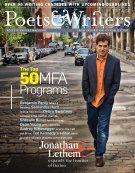For the latest rankings of the top fifty MFA programs in creative writing, read "2011 MFA Rankings: The Top Fifty." For a ranking of low-residency programs, read "2011 MFA Rankings: The Top Ten Low-Residency Programs."
None of the data used for the rankings that follow was subjective, nor were any of the specific categories devised and employed for the rankings based on factors particular to any individual applicant.
The following is an excerpt of an article that appeared in the November/December 2009 issue of Poets & Writers Magazine. The print article, and its accompanying rankings, include eight categories of additional data for each program, including size, duration, cost of living, teaching load, and curriculum focus.
"When U.S. News & World Report last gathered original data about graduate creative writing programs, in 1996, it did so based on two erroneous assumptions. First, it presumed that no part of the writing community was better equipped to assess the relative strengths of the country's then three-score MFA programs than the faculties of the programs themselves. In fact, there was rather more evidence to suggest that no part of the community was less suited to opine on this topic than the one selected. MFA faculties are by definition composed of working writers for whom teaching is an important but often secondary pursuit; likewise, faculty members, because they are primarily focused on writing and teaching within their own programs, have no particular impetus to understand the broader landscape of graduate creative writing programs.
A second major flaw—among many smaller ones—in the USNWR approach was the premise that, unlike every other field of graduate education, graduate study in creative writing was singularly resistant to quantitative analysis, and that therefore the only category of assessment worthy of exploration was faculty opinion on individual programs' "reputations." In fact, every graduate creative writing program has (somewhere) a documented acceptance rate, an annual if changeable funding scheme, and a whole host of less weighty but equally quantifiable data points: student-to-faculty ratio, matriculating-class size, credit-distribution prerequisites, local cost of living, and so on. USNWR ignored all of these.
Irrespective of the approach taken by USNWR, the evils of educational rankings are indeed legion and do urge caution on the part of any prospective analyst of MFA programs. At base it is impossible to quantify or predict the experience any one MFA candidate will have at any one program. By and large, students find that their experiences are circumscribed by entirely unforeseeable circumstances: They befriend a fellow writer; they unexpectedly discover a mentor; they come to live in a town or city that, previously foreign, becomes as dear to them as home. No ranking ought to pretend to establish the absolute truth about program quality, and in keeping with that maxim the rankings that follow have no such pretensions. When I first began compiling data for comprehensive MFA rankings, nearly three years ago, I regularly told the many MFA applicants I corresponded with that educational rankings should only constitute a minor part of their application and matriculation decisions; that's a piece of advice I still routinely give, even as the creative writing MFA rankings I helped promulgate have become the most viewed and most utilized rankings in the field—read online by thousands of prospective MFA applicants every month.
None of the data used for the rankings that follow was subjective, nor were any of the specific categories devised and employed for the rankings based on factors particular to any individual applicant. Location, for instance, cannot be quantified—some applicants prefer warm climates, some cold; some prefer cities, some college towns; and so on—and so it forms no part of the assessment. Other factors traditionally viewed as vital to assessing MFA programs have likewise been excluded. For instance, conventional wisdom has been for many years that a program may be best assessed on the basis of its faculty. The new wisdom holds that applicants are well advised to seek out current and former students of a program to get as much anecdotal information about its faculty as possible, but, in the absence of such information, one must be careful not to confuse a writer's artistic merit with merit as a professor. In the past, too many applicants have staked years of their lives on the fact that the work of this writer or that one appealed to them more than others, only to find that the great writers are not always the great teachers, and vice versa. Likewise, mentoring relationships are difficult to form under even the best of circumstances, particularly because neither faculty member nor incoming student knows the other's personality and temperament in advance. In short, determining whose poetry and fiction and memoir publications you most enjoy yields little information about whose workshops and one-on-one meetings you will find most instructive and inspirational.






